G.Skill RipjawsZ F3-2133C9Q-32GZH
The G.Skill RipjawsZ represents further
revolution of the RipjawsX series that we have discussed above. The first Ropjaws
kits were marketed as quad-channel memory for LGA2011 platforms but ultimately,
this name was applied to the specific shape of the radiators and the RipjawsZ was
also positioned as dual-channel memory for LGA1155 platforms as well. The
F3-2133C9Q-32GZH illustrates this revolution. It was originally meant for
X79-based mainboards but the compatibility list was expanded after the release
of Ivy Bridge CPUs and now includes many Z77-based mainboards.
The RipjawsZ F3-2133C9Q-32GZH is
transported in an plastic blister wrap, like other memory kits from G.Skill.

G.Skill
RipjawsZ F3-2133C9Q-32GZH
Now, let’s take a look at their exterior
design. Their radiators are different from other radiators of the RipjawsX
modules. They are still made of aluminum but the color is switched into
glossy black. Furthermore, the radiators have become somewhat more solid, yet
the RipjawsZ modules are still not too tall and are not likely to conflict with
massive air coolers for CPUs. The full height of each module is 40mm, exactly
as that of the RipjawsX series.

The
radiators are still made of aluminum but the color is changed into glossy black
We have no doubts about the cooling
performance of the RipjawsZ radiators. The modules are not as hot as their cousins,
while the radiators are shaped sophisticatedly to enlarge the total heat dissipation
area.
The radiators are fixed on the memory chips
with a gluey thermal interface material. Below them, we can find a specific
BrainPower PCB of G.Skill products and specially selected 4-gigabit DDR3 SDRAM chips
from Samsung. The components have a good overclocking reputation. The B83U854 1.00
PCB is optimized for clock rates above 2 GHz while the SEC HCH9 chips are
perhaps the most popular choice for high-speed overclocker-friendly DDR3 SDRAM.

We
can find selected 4-gigabit DDR3 SDRAM chips from Samsung below the heatsinks
The G.Skill RipjawsZ F3-2133C9Q-32GZH kit
looks good in all aspects, including its specifications. Its four 8GB modules
can work in DDR3-2133 mode which is not covered by the official specifications
of CPU-integrated memory controllers.
The RipjawsZ F3-2133C9Q-32GZH had a
slightly higher default voltage but can work at CL9. This is reflected in the duplicated
XMP profiles:

The
duplicated XMP profiles
This DDR3-2133 SDRAM kit is a true
overclocker-friendly product whose rated mode is beyond normal standards. It
undergoes presale testing and comes with a lifetime warranty, but G.Skill
guarantees its stable operation with only a limited number of mainboards mostly
include top models from ASUS, Gigabyte and MSI based on Intel's Z77 chipset.
Specifications
·
32 GB dual-channel kit consists of four memory
modules, 8 GB each
·
Nominal frequency: 2,133 MHz
·
Timings: 9-11-11-31-2T
·
Supports XMP
·
Voltage: 1.6 V
G.Skill TridentX F3-2400C10Q-32GTX
G.Skill’s top overclocker-friendly products
are marketed under TridentX trademark. In addition to extreme specifications
and a special version of aluminum heatsinks, this series are different from
other DDR3 SDRAM in some more ways. The TridentX series was launched with the Intel
Z77 platform, its visiting card being the transformer heatsinks that can change
their size and appearance.
Including four 8GB modules of DDR3-2400
SDRAM, the G.Skill TridentX F3-2400C10Q-32GTX has the same packaging as other
G.Skill products. It is shipped in a dual-sided blister wrap.

G.Skill
TridentX F3-2400C10Q-32GTX
The radiators of the TridentX series are completely
different from other solutions from G.Skill. neatly produced, they are pretty
heavy though they are made of aluminum. The bottom of each radiator that covers
the DDR3 SDRAM chips is a pair of thick black bars with a textured surface. The
top is a red aluminum superstructure with a complex configuration styled as
tongues of flame.

The
radiators of this TridentX series are completely different
It is not the impressive appearance but the
transformability that is the main feature of these radiators. G.Skill listened
to complaints from users that tall heatsinks had low compatibility with massive
CPU coolers, so the top (red) part of the heatsink can be removed by unfastening
two screws. As a result, the total height of a TridentX module is dropped from
54 to 40mm, allowing selecting between aesthetics and practicality. In their
shortened version, the TridentX modules will not conflict with normal large-size
CPU coolers.

The
top (red) part of the heatsink can be removed by unfastening two screws
The shortened radiator is quite effective to
cool the eight memory chips on both sides of each module. The G.Skill TridentX F3-2400C10Q-32GTX
modules are not very hot as they are based on 30nm DDR3 SDRAM chips. The
maximum temperatures we spotted during the test was over 53°C.
Rated for 2400 MHz, these modules have the
same parts as the 2133MHz RipjawsZ F3-2133C9Q-32GHZ. Therefore, it is all about
choosing the best chips. The TridentX uses the same SEC HCH9 components but
from a different batch. Thanks to the high overclocking potential and low heat
dissipation, these chips have a good reputation and are widely used in high-speed
memory modules. Again, the PCB is produced by BrainPower. Each 8GB module has a
total of 16 chips, 4-gigabit in capacity each.

The
PCB is produced by BrainPower
The voltage is increased to the maximum
limit allowed for Intel’s DDR3 SDRAM controllers, which is normal for
high-speed memory. The good news is that the TridentX F3-2400C10Q-32GTX
features rather low timings. That's especially good considering that it is a
four-piece memory kit.
The high clock rate and CL10 timings narrow
the range of compatible mainboards. G.Skill guarantees the TridentX F3-2400C10Q-32GTX
will operate with about 2 dozen Z77-based mainboards from ASUS, Gigabyte and
MSI, but we guess that there won’t be problems with many other products. To
simplify installation, these modules support XMP 1.3. The single XMP
configuration (it is duplicated for more stability) contains the same clock rate,
voltage and timings as you can see in the official specifications. Considering
that the Ivy Bridge memory controller is flexible and easy to configure,
releasing this memory at 2,400 MHz won’t be a problem at all. You will not have
to do any setting up for this memory kit but their SPD unit contains DDR3-1333
settings just in case.

The
single XMP configuration contains the same clock rate, voltage and timings
All TridentX F3-2400C10Q-32GTX modules
under presale testing at the manufacturer’s facilities and comes with a
lifetime warranty.
Specifications
·
32 GB Dual-channel kit consists of four memory
modules, 8 GB each
·
Nominal frequency: 2,400 MHz
·
Timings: 10-12-12-31-2T
·
Supports XMP
·
Voltage: 1.65 V